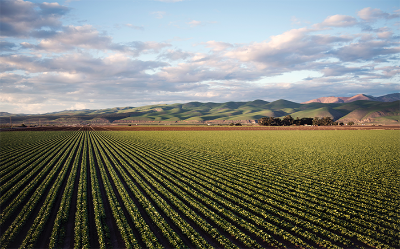
May 2, 2022
The Importance of Agriculture to the California Economy
California is well-known for its diverse agricultural offerings; from beef to avocados to dairy, the Golden State puts a premium on producing the best.
Special Holiday Hours: December 24 - Early close at 3:00pm. December 25 – Closed in observance of the Christmas federal holiday. January 1, 2026 - Closed in observance of New Year's Day. ATMs, online and mobile banking services are available 24/7. Please schedule your Treasury Management needs accordingly.

Agricultural debt is common among farmers and ranchers who purchase land, buy equipment, and invest in technology and tools that allow for greater production and efficiency.
But when times get tough, it can be hard to keep up with large debt payments. If you find yourself in a situation where you’re having trouble paying what you owe, there are steps you can take to restructure your farm debt and ensure you’re able to enjoy financial stability once again. Here are some tips from Community West Bank. Explore your options now, and see how you can stabilize your agribusiness.
1. Keep Accurate Financial Documents & Assess Ways to Reduce Spending
It’s very important to track cash flow, profit and loss, and other metrics of your farm or ranch business health. This can help you be more proactive — if you notice losses or lower-than-usual profits right away, you can take immediate steps to remedy the situation.
Tracking every dollar your farm or ranch spends also reveals ways to reduce expenditures, which will allow you to pay down your debt more quickly. Even in well-run farms, there are often areas in which you can cut costs and expenses and free up more cash to deal with your debt load.
2. Extend Payments with a Longer Amortization Schedule
One option for some agricultural loans is to contact your lender to discuss extending your loan period and amortization schedule. Basically, you’ll refinance your loan into a longer loan term, such as turning a 5 year loan into a 10 year loan.
This means your monthly payments will be lower. However, you will pay more interest overall during the loan period. This is a good option if you’re having cash flow issues and can’t make monthly payments, but is more costly in the long run.
3. Refinance for a Lower Interest Rate
Today, we’re living in an era of unprecedentedly low interest rates. You may be able to contact your lender to refinance your loan and get a lower interest rate, particularly if the loan was taken out a long time ago, or your credit score has improved since you took out your initial loan.
A lower interest rate will lead to lower monthly payments which may result in a lower overall cost for your loan. Depending on the situation, you may even be able to shorten the loan term to cut the total loan cost even more.
4. Consolidate Multiple Agricultural Loans with Refinancing
If you have multiple agricultural loans and you’re having trouble repaying them, you may want to consider debt consolidation. In this method of restructuring farm debt, a single lender pays off your other loans — and then you’ll repay the full amount of this loan directly to a single lender.
This lets you consolidate different higher-interest loans into a single payment, which can make it easier for you to repay and manage your finances. In some cases, your debt consolidation loan may also have a lower interest rate than each individual loan, which helps you save money on debt repayment.
Need Help with Agricultural Financing? See What We Can Do for You
Community West Bank fulfills the financing needs of our farmer and rancher clients with Farmer Mac mortgage loans for land acquisition, loans to refinance existing debt, and financing for capital improvements.
For information about available funding for land acquisitions, refinancing, or other lending options for agricultural projects, please contact us to get started.
This website uses cookies to provide a better user experience, as explained in our Online Privacy Policy. By continuing to use this website, you accept the terms of our Online Privacy Policy and our usage of cookies.